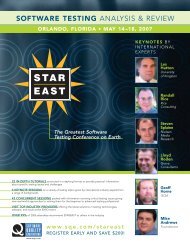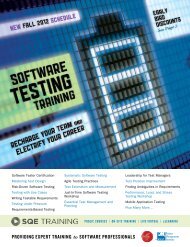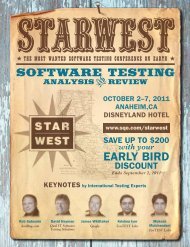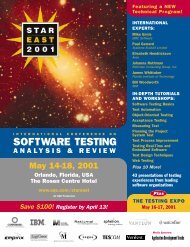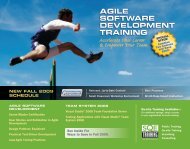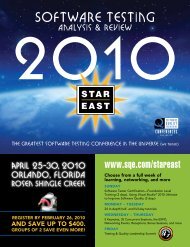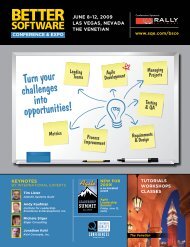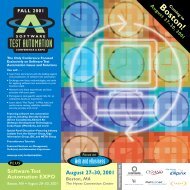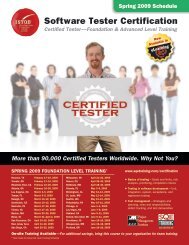Agile Development Practices Conference - SQE.com
Agile Development Practices Conference - SQE.com
Agile Development Practices Conference - SQE.com
Create successful ePaper yourself
Turn your PDF publications into a flip-book with our unique Google optimized e-Paper software.
pre-conference tutorialsTUESDAY, november 10, 8:30-12:00half-DAY MORNING TUTORIALSTD Better Decisions Through CollaborationJean Tabaka, Rally Software <strong>Development</strong>Join Jean Tabaka for an exploration of better decision making through collaboration and facilitation.In this exercise-packed session, learn and apply facilitation tools and techniques that support acollaborative mode of decision making for the planning, daily interactions, and reviews especiallyuseful for agile software development project teams. Jean leads you in evaluating collaboration versus<strong>com</strong>mand-and-control leadership styles, collaborative decision-making, and the facilitation techniquesvital for effective planning and directing collaborative meetings and interactions. Working in smallteams, facilitate decisions through a series of exercises. Practice helping teams gather insights andarrive at decisions without taking over and making the decisions yourself! It is all about making better,more insightful decisions that enable high-performing teams. Be prepared to be on your feet, bechallenged, and watch your skills grow!TE Prioritizing Your Product Backlog NEWMike Cohn, Mountain Goat SoftwareA fundamental premise in all agile development is that work will be done in priority order. Yet, verylittle advice is provided to product owners about how to prioritize a product backlog. Regardless ofhow fast your agile team is, how brilliant your technical solutions are, or how many automated testsyou run continuously, nothing matters if you’re working on the wrong features. Mike Cohn examinesboth financial and non-financial methods of prioritizing product backlog items. Mike describestechniques—relative weighting, theme screening, theme scoring, Kano analysis, impact estimation—and financial measures such as return on investment (ROI), net present value (NPV), internal rateof return (IRR), and discounted cash flow. Not only are these techniques helpful for prioritizingproduct backlog items, they also can be used for prioritizing ideas for entire projects. The techniquesare easy and the concepts are powerful. Take back practical knowledge about how to apply thesestraightforward techniques to prioritizing your product backlog.TF Writing Effective Use Cases in the <strong>Agile</strong> Age NEWAlistair Cockburn, Humans and Technology, Inc.Based on his award-winning book recognized as the industry standard, Alistair Cockburn showsyou how to write use cases that are short, effective, and elegant. A good use case has a mainsuccess scenario, plus scenario extensions that cover situations that may arise along the way. Whatmakes a use case great? It is the writer’s understanding of the scope of action, alertness to thelevel of the goal in each step, clear movement of information and responsibility between actors,the use of goal-oriented verbs, and a story line that ties the steps to a goal of the primary user.When these guidelines are applied, even <strong>com</strong>plex use cases be<strong>com</strong>e short and simple enough forlay people to understand and critique. Learn the critical but often unstated ground rules aboutscope, goal level, and actors. Discover how to collect and simplify use cases, and how to slice themfor agile development.TG <strong>Agile</strong> Chartering: Inspiring, Aligning, and EvaluatingProject Communities NEWJoshua Kerievsky, Industrial Logic, Inc.Having a vision for your product or project is not enough. All project participants must be alignedwith essential organizational objectives, inspired to achieve great things, and evaluated on whetheror not their work is successful. But, what is “success”? <strong>Agile</strong> teams need “connective tissue” betweenexecutive management’s vision for a product and how everyone engaged in development anddelivery defines success. Without a clear charter, it’s possible to be “agile” and build well-testedsoftware that fails to meet key organizational and customer needs—a technical success but a businessfailure. Joshua Kerievsky has been helping groups craft and evaluate agile project charters since2001. He explores what agile chartering is, how to do it, the pitfalls to avoid, and shares his real-worldexperiences from the trenches. Learn chartering through hands-on experience by producing elementsof a charter as you discover the best ways to conduct chartering in your organization.TH Techniques for Measuring Team VelocityRob Myers, <strong>Agile</strong> InstituteThe velocity metric is often misunderstood and unintentionally misused by both management anddevelopment. Developers worry they’re being evaluated based on this number. Managers want toknow how it can be increased. How a team defines velocity—explicitly or implicitly— affects theteam’s ability to meet delivery <strong>com</strong>mitments. Velocity must be rigorously defined and consistent;otherwise planning efforts quickly unravel. Rob Myers clarifies velocity—its definition and use. Robexplores velocity as a realistic planning tool, offers various ways to measure velocity, and presentssimple analogies that make it understandable. Learn effective ways to obtain consistent estimates,discuss approaches to planning iterations and releases, and track your progress. Realistic, groupexercises explore and reinforce these analogies including playing the “Team Estimation Game” andtalking briefly about Planning Poker®. Learn what to do about vacations, meetings, sick days, andsurprises, and what to do if the answer to “Are we on schedule?” is “No.”An agile fellow with Rally Software<strong>Development</strong>, Jean Tabaka has morethan twenty-five years of experience in IT.After studying DSDM in the late 1990s, shebecame an agile devotee, working withorganizations worldwide to deliver morevalue faster through the adoption of agileprinciples and practices. Specializing inscaling agile practices, guiding leadership shifts, applyinglean, and building continuous planning practices, Jean usesa collaborative approach in helping organizations adoptagile. A Certified ScrumMaster Trainer and a CertifiedProfessional Facilitator, Jean is the author of CollaborationExplained: Facilitation Skills for Software Project Leaders.You can reach her at jean.tabaka@rallydev.<strong>com</strong>.A Certified Scrum trainer, Mike Cohn isthe founder of Mountain Goat Software,a process and project managementconsultancy and training firm. He is theauthor of newly published Succeedingwith <strong>Agile</strong>: Software <strong>Development</strong> usingScrum, <strong>Agile</strong> Estimating and Planningand User Stories Applied for <strong>Agile</strong>Software <strong>Development</strong>, as well as books on Java and C++programming. With more than twenty years of experience,Mike has previously been a technology executive in<strong>com</strong>panies of various sizes—from startup to Fortune 40.A frequent magazine contributor and conferencespeaker, Mike is a founding member of the ScrumAlliance and the <strong>Agile</strong> Alliance. He can be reached atmike@mountaingoatsoftware.<strong>com</strong>.Alistair Cockburn, one of the foundersof the agile movement, was voted one ofthe “The All-Time Top 150 i-TechnologyHeroes” in 2007. He calls himself a“project witchdoctor” because peoplestill don’t understand how improvingtrust and <strong>com</strong>munication improvesproject out<strong>com</strong>es. Known for his livelypresentations and interactive workshops, Alistair isinternationally renowned for his expertise on projectmanagement, agile development, use cases, and teaching.Two of his books, <strong>Agile</strong> Software <strong>Development</strong>: TheCooperative Game and Writing Effective Use Cases, havewon Jolt and Jolt Productivity awards. His blog, poems,articles, and talks are available online athttp://alistair.cockburn.us.Joshua Kerievsky leads Industrial Logic,a fourteen-year-old <strong>com</strong>pany thatguides organizations in successful agiletransitions. He has more than twentyyears of experience in the software field,is an expert and early pioneer in agilemanagement and Extreme Programming,and is a prolific author of eLearning albumsthat help <strong>com</strong>panies around the world “scale agility faster.”Joshua’s 2004 bestselling book, Refactoring to Patterns,won a Jolt Cola award. His pioneering work in agileprocesses has helped popularize readiness assessments,storytest-driven development, and agile chartering.For more than ten years Rob Myers hasconsulted on numerous successful agile,Scrum, and extreme programming (XP)projects. During his more than twentyyears in various software developmentroles, he has enjoyed consulting for leading<strong>com</strong>panies in the aerospace, government,medical, software, and financial sectors.The lead instructor of the <strong>Agile</strong> Institute and a foundingmember the <strong>Agile</strong> Cooperative, Rob teaches a variety ofcourses, including Realistic Test-Driven <strong>Development</strong> andRealistic <strong>Agile</strong> Testing with Fit. Every course is a blendof highly technical experience coupled with techniquesfor preserving sanity in the workplace. Rob also performsshort- and long-term coaching to encourage, solidify, andimprove the team’s agile practices.12Call 888.268.8770 or 904.278.0524 to register • WWW.<strong>SQE</strong>.COM/ADPREG



